Generally, woodworking requires more skills and precision, and you cannot go for a tool that is not powerful enough to perform the task precisely. The thickness planer is one of the most essential tools needed for woodworking. Any woodworker requires the best thickness planer to give thickness to wood boards and make their surface smooth. They could perform the other tasks by hand, but making the smooth wooden boards is not that much easier. So, if you are one of those beginner or professional woodworkers looking for the best thickness planer, don’t panic, as this detailed article on multiple best thickness planers will make your selection process easier.
Whether you are a pioneer of woodworking or a beginner DIYer, having the best thickness planer at a workshop or home can level up the working efficiency. With the variety of thickness planers available in the market, you might need help to choose the one. Therefore, I assembled the list of 10 best thickness planers based on my personal experience. Besides, you will find the essential factors you need to consider before choosing the best thickness planer. Let’s deep dive into the topic and explore a variety of thickness planers.
What To Consider When Selecting The Best Thickness Planer?
Thickness planers are available in various sizes, styles, and working efficiency. Choosing one can be challenging when there are numerous options in front of you. Buying a thickness planer that cannot fulfill the requirements of your specific project will cost you a lot, especially when you need experience. Therefore, it is necessary to carefully consider some important factors before buying any thickness planer. We will discuss all the required considerations one by one that you need to focus on while shopping.
Cutterhead styles for thickness planer
One of the most critical considerations of planers is the cutterhead style. The cutter head or blades help to cut down the wooden boards and shape the rough lumber. Generally, there are two types of cutter heads for thickness planer. One is the straight knife that is traditionally used, and the other is the spherical or helical-style cutter.
Straight knife style cutterhead
This type of cutter head you will mostly find in the benchtop planers. It usually contains more than two knife-like straight blades, typically 2 to 4 blades. The straight steel knife cutterhead is more affordable than the other type of cutterhead. It could be the one reason that it is more prevalent among woodworkers. These are easily replaceable due to the lower cost.
Helical or spherical cutterhead
The second type of cutterhead differs from the first one as it contains various small square-shaped cutters or blades fastened through the inserts. Although straight knife cutter heads are more famous among woodworkers, helical cutter heads have their benefits. These are easily replaceable when there is any damage occurs.
If you ever face any situation while working with the spiral cutter head, get your inserts damaged. At first, you don’t need to replace the whole blade. You can change the angle of the inserts by slightly loosening it. These cutter heads can cost you more, but it could be a one-time investment as they cut sharply and maintain this ability for extended periods.
Model of thickness planer (benchtop, stand alone & combo)
When it comes to models of thickness planer, there are three main categories. One is the hand electric planer, the second is a benchtop planer, and the third is the stand-alone planer. In addition to these main categories, there is one more thickness model: a combination of planer and jointer.
Hand electric planer
Hand-electric planers use manual operation, but you can find various handheld planers. These are very handy due to their small size and style. They can be used for small types of jobs and projects. Even you can find these kinds of electric planers in a cordless form that allows you to carry them to those places where electric supply is not available.
Benchtop planer
It is clear from its name that a benchtop planer is the kind of planer you can place easily on your workstations. These fall in the affordable category of the planers that anyone can own for performing the woodworking process at home or in a workshop. Benchtop planers come in two variants: one is portable, and the other one is not. Those benchtop thickness planers that are not portable are for placing in the workshops and come with more weight and bigger size. On the other hand, portable or lunchbox thickness planers feature less weight to carry to the job’s location. Benchtop thickness planers are less expensive and more popular among professional woodworkers.
Despite affordability, these thickness planers may show some restrictions when you want to work with rough and hardwood because these are less powerful than the other types of thickness planers, including stationary and combo planers.
Stationary or Standalone Planer
Stationary or standalone thickness planers are more prominent and cover more space than the benchtop planer. You can place it on the floor without any support. The standalone thickness planer is best used to perform heavy-duty projects. Buying such kind of planer could be costly, but they come with more versatile features such as highly powerful motors, more width capacity, and sharp cutter heads. However, its high cost, more space coverage, and non-portability make this less popular among woodworkers.
Combo Planer (planer & jointer)
This type of thickness planer has dual functionality. The thickness planer can be converted into the jointer when needed. If the woodworker’s workshop does not allow multiple tools, this combo thickness planer is a great space-saver option. This combination thickness planer features all the abilities of a standalone thickness planer plus the ability of power jointers. These are perfect for performing more robust projects.
Motor Power of Thickness planer
Thickness planers come with various motor power capacities. The need for motor power depends on the type of project. If you want to buy a thickness planer for performing different kinds of projects, then you need to buy a powerful motor that can fulfill the demands of each project. Otherwise, you don’t need to buy a heavy motor thickness planer If the budget is your priority.
For cutting softer woods such as cedar and pine for making small birdhouses or cabinets, the motor with 1 to 1 ½ HP will be suitable. On the other hand, when dealing with harder woods such as walnut, oak, and maple, you need to buy the thickness planer with a high horsepower motor of approximately 2 HP.
Compared to the benchtop thickness planer, the larger planer has more HP for woodworking efficiently. The more significant thickness planer has a Hp of 3 to 5.
Besides, you need to focus on the amperage rating of the thickness planer. The most suitable amperage rating is 15 amp, which can control the project without breaking down. If you choose less amperage power than 15, it will not perform the task efficiently.
Size or Capacity of thickness planer
Another essential factor you need to consider is the thickness of the planer’s capacity or size. All thickness planers have different lengths or widths ability. The width capacity of the thickness planer defines how much wider the wooden board you can pass through the thickness planer. If the width of the planer is 12 inches, then you cannot pass the board wider than this.
Similarly, a thickness planer with 13 13-inch width capacity can only pass the board that is 13 inches wide. Having the planer with more width capacity can allow you to cut the broader boards easily and help you to perform the more extensive project. However, if you think that width capacity can alter the size of the machine, then you are wrong. You don’t need to worry about this; it will take up the same space in your workshop.
However, if you want more width capacity, consider a stand-alone or combo-type thickness planer. These usually have a width capacity of 15 inches to 25 inches.
Cutting Depth
Cutting depth is necessary to consider before buying any thickness planer. The primary purpose of a thickness planer is to shave off the wood strips to give them the required thickness. So, it is necessary to understand the wood-cutting capacity of a thickness planer in one pass. The powerful planer can cut the wood deeper and remove more material in a single pass.
Planers with a cutting capacity of 1/8 inch of rough wood in a single pass are considered ideal. But removing that large amount of wood at a time is only sometimes necessary. So, consider those planers that remove less material by considering the safety of materials and the tool. Planing multiple wooden boards at the same time can result in overheating the machine. If you need to remove less material, then there is no need for a thickness planer with a cutting capacity of more than 1/32 or 1/64 of an inch.
Additionally, adjusting the depth in the thickness planer should be handy. While planning, you need to gauge the cutting depth. So the best thickness planer should have gauges, scales, and visible direction of trimming the boards.
Noise level of thickness planer
Generally, the electric thickness planer falls among the category of noisiest tools. While working in the workshop or the home garage, they create a great noise that can disturb the other family members and the neighbors. You need to protect your ears by using the earplugs. Another way of leveling down the noise level is maintaining the blade sharp. The sharper edges create less noise. However, still, you need to protect your hearing.
Speed of thickness planer
When it comes to the speed of the thickness planer, this term applies to different types of speeds such as cutting speed, cutter head speed, and feed speed.
Cutting Speed
The cutting speed of the thickness planer describes the number of times the blades touch the surface or wood within a minute. Suppose your planer has two blade cutter heads with a rotating speed of 8000 rpm; then its cutting speed will be 16000 cuts within a minute. The more rpm means, the more incredible cutting speed and the acceptable results.
Cutterhead Speed
Secondly, the cutter head speed describes the capacity of the motor to spin the cutter head within a minute, and the unit of speed is counted in rpm (rotation per minute). The thickness planer with the cutter head speed of 8000 rpm can give the best results. Most powerful thickness planers use a motor that can spin the cutter head using pulleys and belts.
Feed Speed
The third one is the feed speed of the thickness planer, which describes the rate at which a board passes under the cutter head of the thickness planer. There are different models of thickness planers, and some of them allow you to alter the feed speed. This way, you can manage the CPI (cuts per inch) the planer’s blades create. If you work on a higher feed speed, your board passes quickly through the planers, and as a result, you will find the rough board. You can find the smooth panels if you work on the lower feed speed.
Dust Collection
.While working with the thickness planer during woodworking, maintaining a clean and safe environment is necessary. The thickness planer or the benchtop planer can create a significant amount of dust and wood chips while cutting the wood. The thickness planer has dust ports that can attach to the specific dust collection system or a vacuum to prevent the mess from spreading. However, some thickness planers need to have built-in dust collection systems. For those, you might need to buy a separate one.
To keep the shopping within your budget, check whether the thickness planer you will buy has a dust collection system. Besides maintaining the area clean, the dust collection system is necessary to avoid dust settling up to the cutter head. It will keep the dust away and help sustain the planer’s condition and cutting speed.
Support for thickness Planer
All thickness planers have a solid iron base to control the machine while planing with rough or weathered wood. Not only does it handle the vibration, but it also provides substantial support to the material you want to work on. Larger-thickness planers have solid iron bases, and the infeed and outfeed tables support the heave lumbers. But in the benchtop thickness, planer support is weak and can only support the lighter lumbers.
Top 10 Best Thickness Planers List
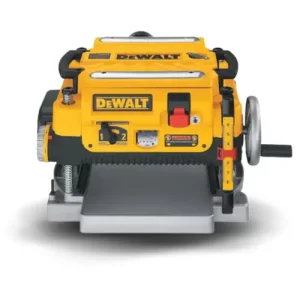
DeWalt (DW735X) Thickness Planer
Powerful, precise, versatile planer with adjustable settings for smooth, professional-grade woodworking finishes.
Key Features
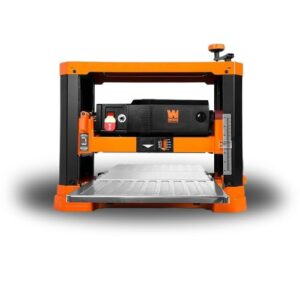
Wen (PL1326) Thickness Planer
WEN PL1326 Planer delivers precision, power, and smooth, professional woodworking finishes.
Key Features
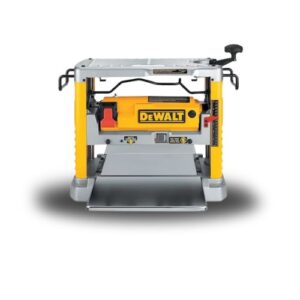
DeWalt (DW734) Thickness Planer
Efficient, durable, precise planer delivering sleek finishes for versatile woodworking projects.
Key Features
1. DEWALT(DW735X) Thickness Planer 13-Inch
The DEWALT (DW735X) Thickness Planer is a powerful benchtop planer with a width capacity of 13 inches, more than any other portable planer. It is the best companion for woodworkers to achieve precision and perfection in their woodworking projects. A two-speed gearbox allows the user to adjust the feed speed at 96 and 179 cuts per inch (CPI), which is beneficial for cutting the desired material and getting a smoother finish.
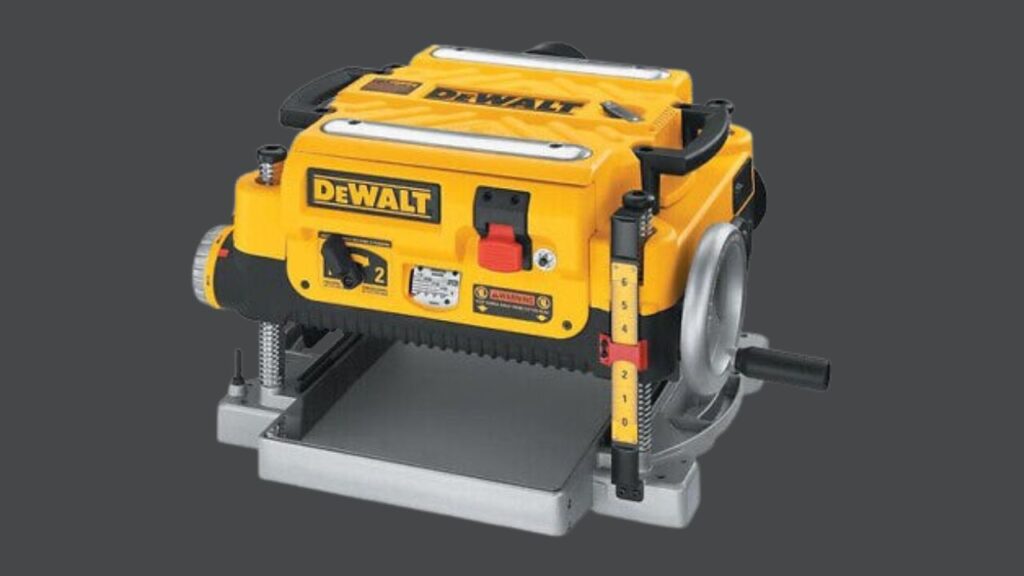
This planer boasts 15 AMP and 20,000 RPM motors that can easily cut the wider boards. The DW735X features a three-knife cutter head that gives less noise and efficient cutting. The fan-assisted chip ejection system keeps the workplace clean and ensures uninterrupted operation. Another essential feature of this benchtop planer is that it is equipped with a 19-3/4-inch cast aluminum base that is two times more rigid than a standard 10-inch base.
My Experience
I needed to build a flat board for one of my projects, so I decided to use a DEWALT (DW735X) thickness planer, one of the most popular tools for woodworking. The material that I used was the elm and walnut wood glued together. Before starting the process, I set up the machine. The DEWALT (DW735X) has two speeds, 96 and 179 CPI. More material removal required the planer’s setting at 96 CPI, but I only want to finish the board here.
So, I set it on the 179 CPI. The gauge before the tool tells you how much material will be shed off. I checked that first and put on my 1/64-inch thickness of the board. After setting the dust collector, I fed it through the planer to get the excellent finishing and turned on the planer. Repeat the process three to four times and get a smooth glass finish. At the end, I measured the snipe, and it was near to 0, which couldn’t be felt by hand.
Related:
2. WEN (PL1326) Thickness Planer
When choosing the best thickness planer, WEN is the name that quickly comes to mind. However, WEN has launched various models of thickness planers, but the WEN (PL1326) planer is the one that can serve you with versatility. Its powerful 15 AMP motor provides a speed of 10,000 RPM with a feed speed of 26 feet in a minute. It is the upgraded version of its previous model.
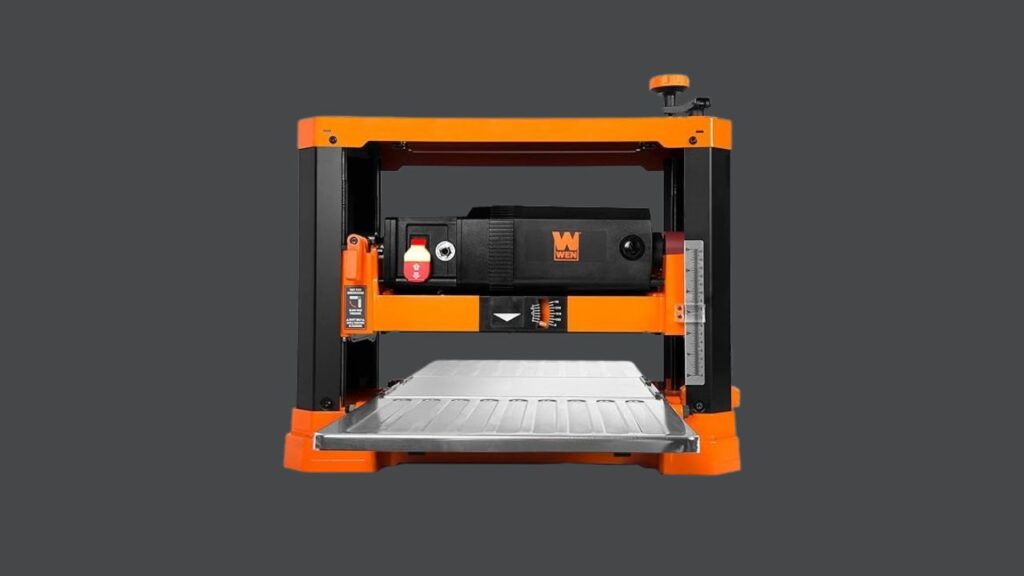
The previous model features the straight knife cutter head, while this one comes with a spiral or helical cutter head. The spiral cutter head consists of 26 (HSS) high-speed staggered blades that provide the crystal-clear finish on the board at the end. Its width capacity is 13 inches, and it can cut up to 6 inches. With the thickness gauge and the dust collection system, working with this model is very easy.
My Experience
A few months ago, I got to work with the WEN (PL1326) thickness planer. This fantastic wood planer with the small blades and the fast speed surprised me with the board’s smooth surface. I used a board that was 12 inches wide. The thickness of the board was three-quarters of an inch, and I needed a board with a thickness of 5/8 of an inch. After making the necessary adjustments, I ran the board under the cutter head.
With a few rounds, I got the sleek and smooth surfaced board ready to use. However, I got a small snipe on one edge of the board. On my first attempt, I noticed grease and oil residues all over the tool. So, it is recommended to wipe it off before using the planer.
3. DEWALT (DW734) Planer
The third best thickness planer on my list is the DEWALT (DW734) Planer, which is efficient enough to perform multiple tasks. It has a 12 to 12.5 width capacity, allowing you to deal with boards with different widths. It features the double-edged and reversible three knives that ease the tool’s usage.
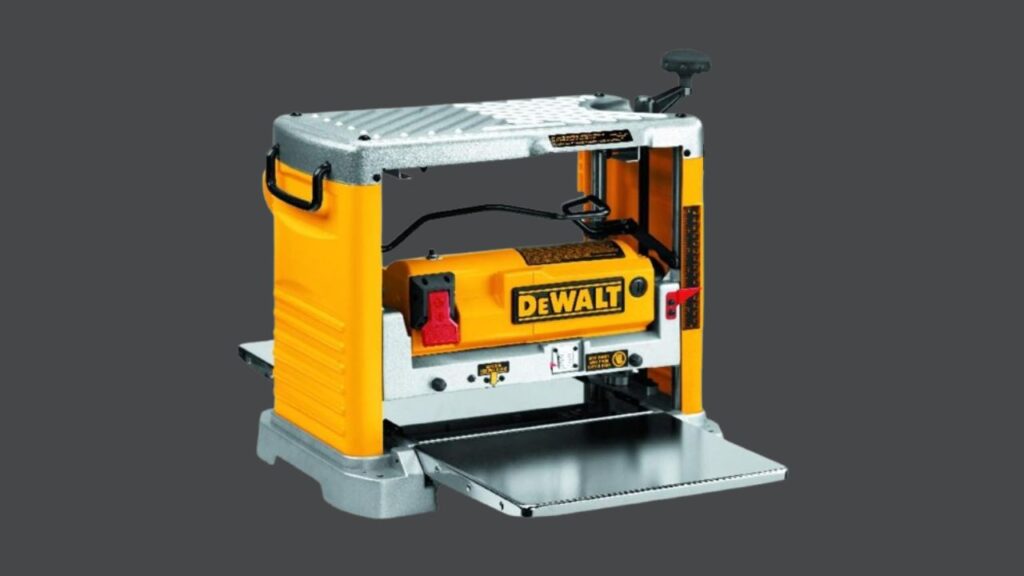
It boasts a maximum 20,000 RPM speed with the help of 15 AMP motor power that allows the woodworkers to deal with soft to solid wood. When the motor produces 10,000 RPM speed, it gives the 96 CPI. Moreover, the DEWALT (DW734) wood planer features the depth adjustment scale, solid infeed and outfeed support, and turret depth stop, which make it the top-rated thickness planer.
My Experience
I tested the DEWALT ((DW734) planer on 2×4 rough lumber. I started by checking the cutting depth and removal of material that would have occurred. After adjusting the lumber, I just turned on the wood planer to shave off the small material. Ultimately, I found a nice, sleek board with better grain quality. I got a little snipe, but that was adjustable by adjusting the inner and outer feed tables. I also tested it on a rough walnut board; the results were impressive. However, there was a need for a little bit of sanding of the board to make it smoother.
4. CRAFTSMAN (CMEW320) Planer
The fourth best thickness planer I mentioned in the list is the Craftsman (CMEW320) Planer, an affordable machinery without compromising the working efficiency. This thickness planer features the 15 AMP motor power that produces the 8,000 RPM cutter head speed.
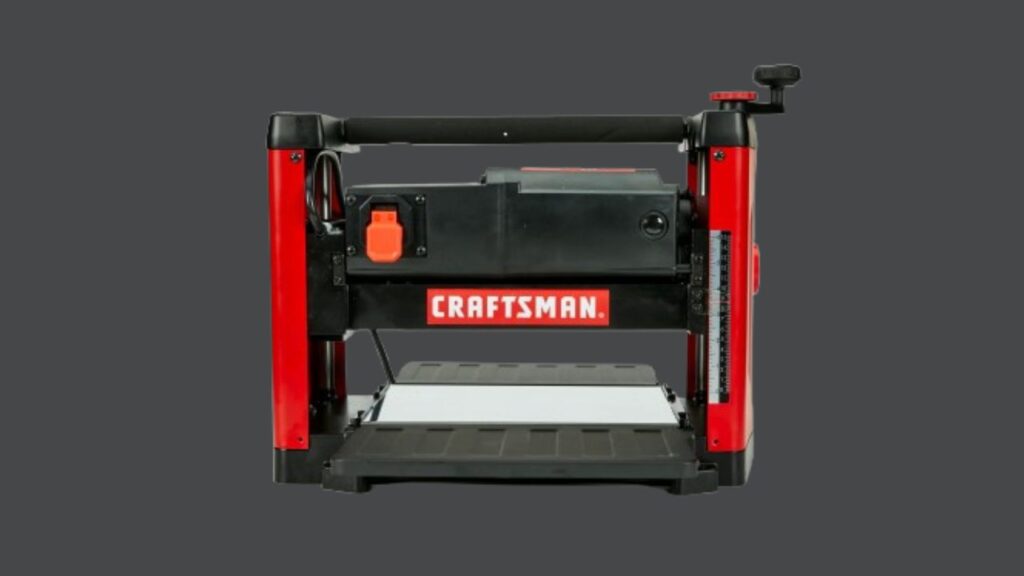
The powerful motor and cutter head speed allows the user to make 16,000 cuts in one minute. The double-edged solid steel cutter head can quickly smooth any wood. Even you can smooth the surface of glued material.
My Experience
To check the quality of the affordable Craftsman thickness planer, I decided to test it on the block of oak. You might think it is not suitable wood for such a planer, but I wanted to see whether it could handle it or not. After setting up the planer, I ran the board through the planer. Surprisingly, it worked well and gave smoothness to the oak board. Again, I tried it on the longer board. The smoothness was perfect but created a significant snipe on one edge.
5. Porter-Cable (PC305TP) Thickness Planer
Another thickness planer is the Porter-Cable (PC305TP) planer, which is a perfect option for woodworkers. It boasts 15 AMP power, making it perfect for planing almost every kind of wood. With the two high-carbon steel and reversible knives, the cutter head speed of 8000 RPM allows you to get 16,000 cuts within a minute.

Moreover, reversible knives are also helpful for maintaining the shelf line of the wood planer. It comes with a Poly-V cutter head that helps it show versatility and cut multiple types of wood.
My Experience
The portable thickness planer is perfect for taking you to the job position. For testing the brand-new planer, I just picked the old flooring piece. Passed the board through the cutter head after adjusting it with the help of the handle present on the top of the planer. It shaved off the material thoroughly and gave a nice and smooth surface without sniping. Then, I tested it on the rough oak piece. The results were perfect with the sleek surface of the board. Later, I used it for my Kitchen Island project, and it was an incredible experience.
6. WEN (PL1252) Thickness Planer
When dealing with rough and reclaimed wood boards, consider a WEN (PL1252) thickness planer. The most robust planer features 15 AMP motor power to remove the 1/8-inch wood of 12.5-inch wide boards. It can create 10,000 RPM for planing the wood.
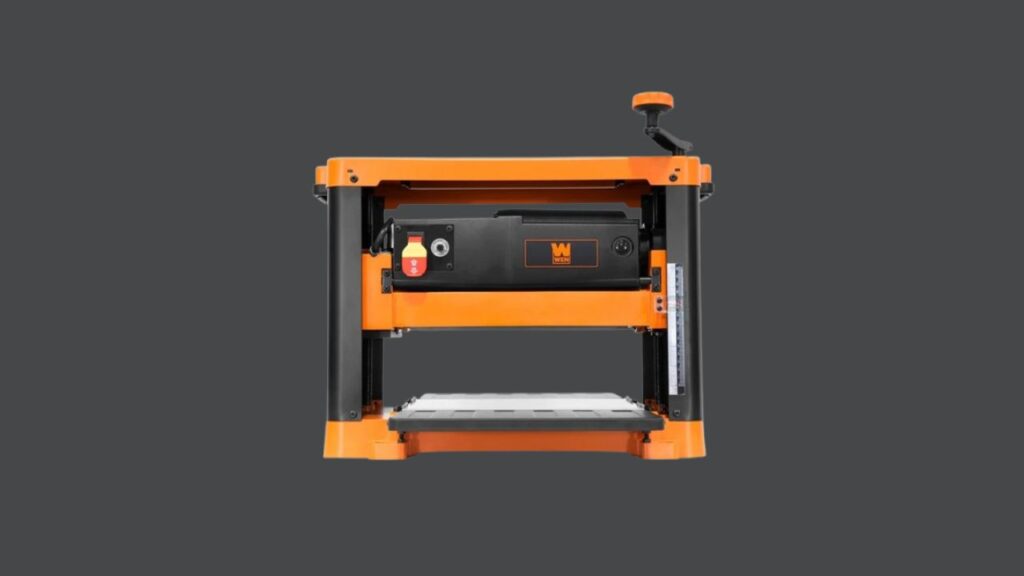
It can make 20,000 cute per minute with a feed speed of 26 feet. This WEN planer features a 2-inch dust port that can collect dust and chips, providing easy woodworking. With a height adjustment handle, it is handy to set the level of boards to avoid snipes. The lightweight is approximately 55.6 pounds, and the WEN planer is ready to transport from one place to another.
My Experience
When I needed to work with the WEN (PL1252), I started it setting up. The assembly was super easy and fast. It took me a few minutes to start the process. The depth gauge in front of the planer allowed me to check how much material would be removed. I selected the rough lumber for feeding and cutting through the planer. It provided the smooth surfaced boards with unnoticeable snipe. Even I didn’t need to sand out them. It can pass the 12.5-inch-wide board for milling down.
7. Makita (2012NB) Planer
The Makita (2012NB) thickness planer is designed to carve off the wood for making furniture, cabinets, staircases, and closets. With a width capacity of 12 inches, this planer can cut the lumber which is up to 1/8 inch thick. The most important feature of this Makita (2012NB) thickness planer is it provides a maximum 6 3/32-inch height capability that roughly shows any other wood planer. you can achieve stable and noise-free operation while working with this planer.

The two straight knife cutters, with 15 AMP motor power for producing the 85000 RPM on the cutter head can quickly cut the board up to 1/8 inch. For smoother cutting, This Makita thickness planer features the internal-Lok clamp for holding the board in one place and avoiding snipes.
My Experience
Another best thickness planer that I tested ever was the Makita (2012NB). It has a small gauge in front of the machine. When you put the board under this it gives you the reading about how much material is going to remove. With the help of the handle above, I managed to set the board in the planer. after that, I turned on the tool and ran the lumber through it.
It gave a smooth surface that is near to the finish, in just a single pass. The next test was done on the Romberg wood which is medium to hardwood. After a few passes it gave a smooth and plain surface. So you can use it for soft to hard material without making any extra effort.
8. WEN (PL 1337) 13-Inch Spiral Benchtop Thickness Planer
Another WEN model of thickness planer that takes its position into the top 10 best thickness planer list is the WEN (PL1337). This model works on two different speed types for efficient cutting and a smoother finish. The dimensioning speed rate is 26 FPM, and the finishing speed is 16 FPM. It boasts the 10,000 RPM cutter head speed, which is produced by the 15 AMP power of the motor.
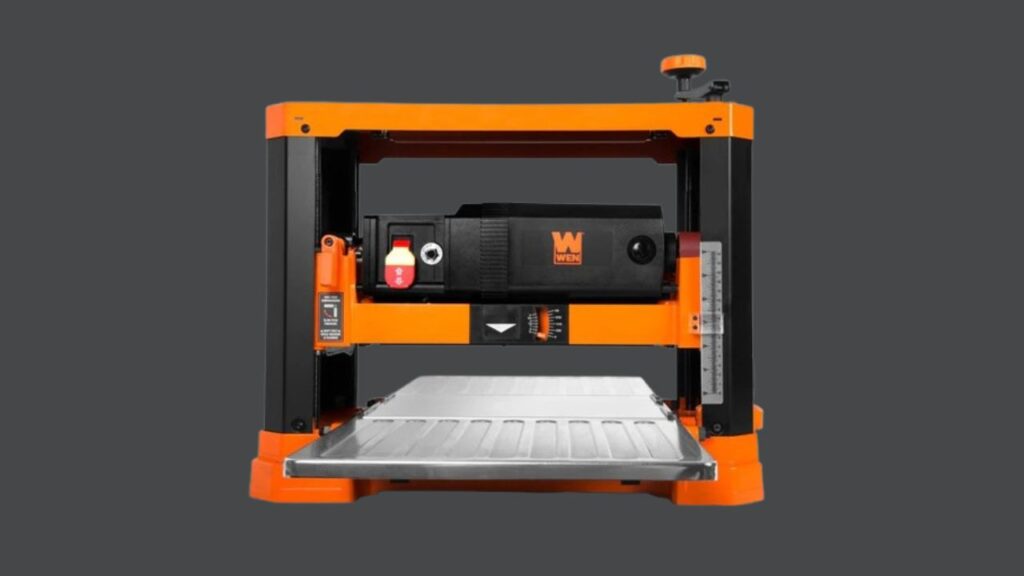
With a width capacity of 13 inches, it can cut down the board up to 6 inches thick. Another essential feature is it carries a heavy weight that prevents it from moving while thickening the boards. It has an adjustable dust port and a depth adjustment scale that makes flawless operation possible—a perfect unit to achieve the precise thickness of boards.
My Experience
When I got a chance to test the performance of WEN (PL1337), I found it more efficient than the 2-3 blade planers. The spiral cutter head lets you plane the rough lumber quickly and efficiently. The setting of this planer was super easy as the proper instructions were provided with it. I passed the hickory board through it by adjusting the required thickness. As you know, hickory has more hardness than the other wood.
Even it created almost no snipe. But it wasn’t easy to plane down the hickory at 1/32-inch thickness. However, it worked well for walnuts in the same settings. According to my experience, it is clear that working with the spiral cutter head reduces the tear-out and snipe.
9. JET (722130) Planer
This is the most suitable thickness planer for woodworkers and could be an excellent addition to their workshop. This 13-inch JET (722130) wood planer has a spiral cutter head that provides a smooth and sleek surface at the end. The helical or spherical cutter head is arranged in 6 rows of 24 inserts to cut the boards efficiently.
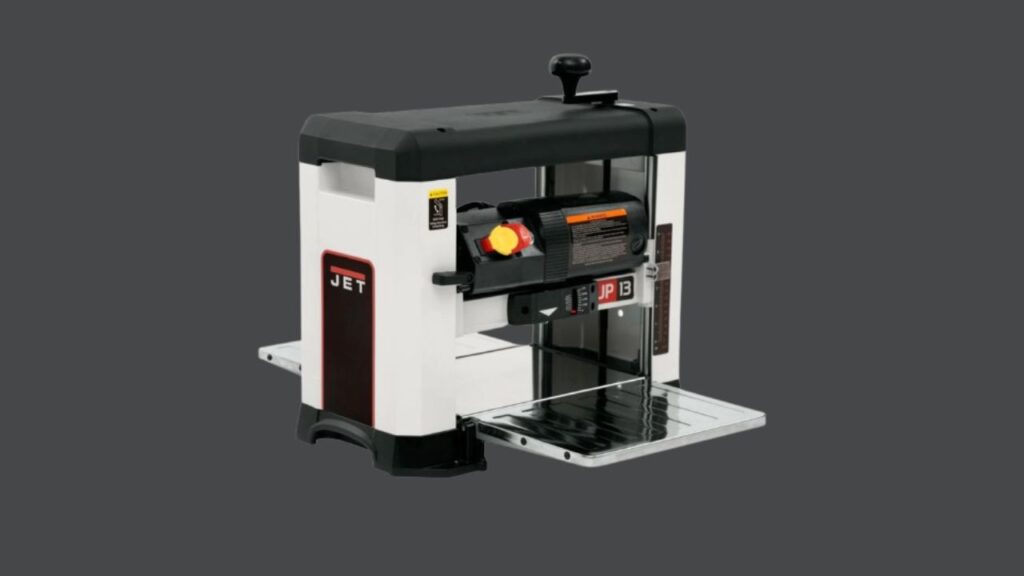
It is considered the quieter tool with a low noise level due to helical cutters. The 2 HP motor produces the 10,000 RPM for cutting. It comes with a solid iron base to prevent the snipe from occurring. Two infeed speeds ensure the precise cutting and finishing of lumber and rough woods.
My Experience
What I experienced with working with this thickness planer is it is a space saver. If your workshop or garage doesn’t have enough space, it could be the best option for you. This compact benchtop planer offers the convenience of using it. Besides being compact and easy to move, it provides a smooth surface for the boards. When I tested this unit on different types of wood, it gave me outstanding results. The surface of the board was smooth and sleek. With the help of the thickness stop, I managed to plane the boards with the same thickness without adjusting repeatedly. However, initially, it created the snipe on the boards, but that was adjustable.
10. Delta Power Tools 22-590X
The Delta Power tools 22-590X is an efficient benchtop planer that gives fantastic results and helps the woodworker efficiently perform the task. It features a three-knife cutter head with relatively longer blades and a cutter head lock system to get snipe-free boards.
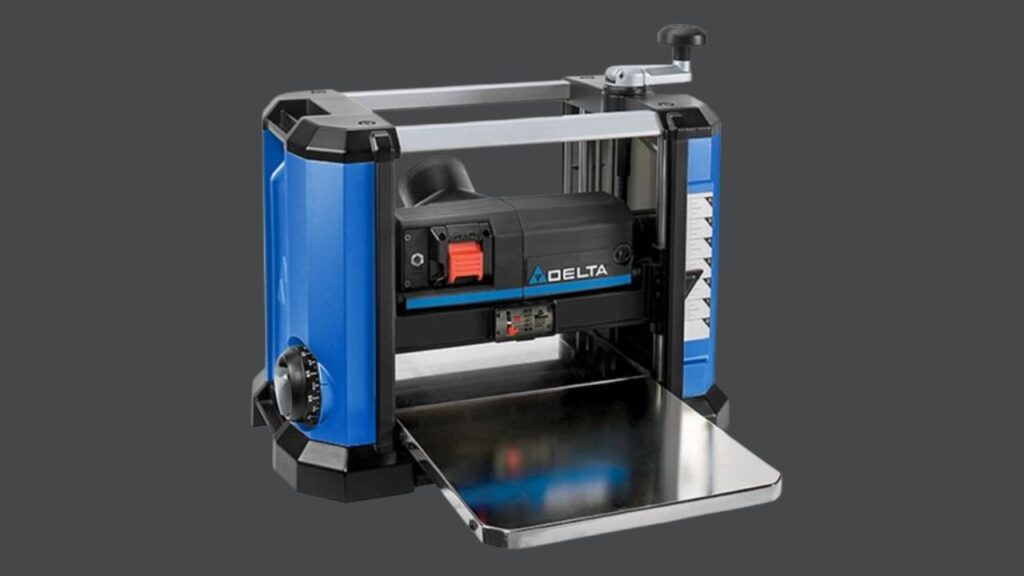
The double-sided knives have high-speed cutting capacity, allowing the user to adjust the dimensions somewhere between ¼ inch to 1/8 inch. The powerful 15 AMP and 120V motor helps to deal with the versatile form of wood (from soft to hard). You don’t need to worry about clogging as it comes with a 4-inch dust port that keeps the dust away from the cutter head.
My Experience
The last thickness planer on my list that I tested a few weeks ago was the Delta Power tools 22-590X. The setting up step for this planer was handy as you can see all the necessary features in front of the planer. With the help of a depth gauge, you can easily see the amount of material that will shave off. I took the 8-inch wide board to test its efficiency. The gauge’s reading was 264th of an inch, which would be removed from the board. After fixing it, I locked the head in one place and pressed the power button. When the process ended, I got the smooth-surfaced wood.
Comparison Between 2 Best Picked Products
Now, I will compare my two best-picked thickness planers so you can easily decide. First, DEWALT (DW735X) and WEN (PL1326) have almost the same features as depth adjustment, thickness gauges, scale, and the same motor power. But with two thicknesses, planers differentiate in the type of blades and the working efficiency. The first one shows a better gauge indicator than the second one. If we compare the noise level, DEWALT is noisier than the WEN (PL1326).
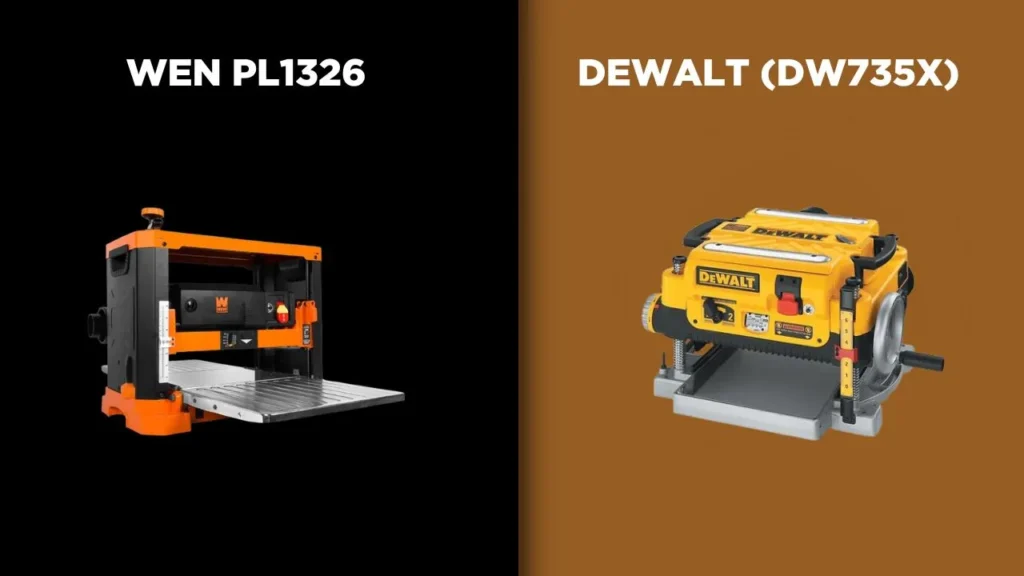
The DEWALT (DW735X) planer features three straight blades that are 13 inches long, while the WEN (PL1326) wood planer has 26 half-inch long blades. The blades of the WEN planer are straight and arranged in a spiral pattern. Based on my experience working on different types of material, the low feed rate option works much better than its high feed rate option and the WEN (PL1326). The table given below compares the features of my two top-pick thickness planers.
| Features | DEWALT (DW735X) | WEN (PL1326) |
|---|---|---|
| Feed Rate: 26 FPM | 96 CPI | 32 CPI |
| Feed Rate: 14 FPM | 179 CPI | N/A |
| Blades | Straight knife | Spiral |
| Cutting quality (according to the material) | Great | Good |
| Noise level | High | Low |
How To Use a Thickness Planer? Detailed Guide
When you have the right thickness planer at your home or workshop, it could be super easy to mil lumber. With the proper wood planer knowledge, anyone can plane the rough lumber in a few minutes. If you are a beginner or a seasoned woodworker who sometimes feels difficulty in using the thickness planer, then the given guide will answer all your questions. Here, I will discuss how to use the thickness planer properly, but first, gather some essential tools.
Material to be needed:
Step 1: Prepare the planer and material
Before starting the procedure, prepare your thickness planer to avoid mishaps during the woodworking process. Start with considering the type of material, whether you want to plane the softwood or a hardwood. Is your material thick enough to pass through the planer? If it needs to be trimmed and prepared to pass under the cutter head, you can do it using a handsaw or sandpaper. Place your planer at the sturdy worktable and secure it with the help of bolts so it can not move due to the vibrations created during the procedure.
Besides, consider some safety measures to avoid injury and harm to your precious wood planer. Each wood planer comes with instructions, and reading them before using the planer is necessary. Follow the given instructions and keep the process flawless.
Step 2: Setting up the planer
The 2nd step involves the preparation of a planer for planing the wood. You need to focus on setting up the wood planer for the desired results. All wood planers come with their own settings and specifications. So, you need to consider the manual given by the planer and make adjustments accordingly.
Set up the height of the blade before using the planer and the cutting depth for the board. You can set this blade at the free height for the first board. After adjusting the height, you can adjust the feed speed to get the desired finish.
Step 3: Start planing the wood
You can start the procedure once you have set up your planer with the required settings. Start feeding the board to your wood planer by maintaining the safety measures and keeping your hands away from the blades. When you are on the planer, and your board passes through the infeed and outfeed tables, the cutter head starts cutting the wood boards. You should remove the small material first instead of removing more material at once. Because even if some extra material is left, it can be adjusted during the sending procedure.
Step 4: Plane the edges
Once you are done planing the flat surface of the wood, it’s time to clean the edges. Start passing the board through the planer by placing the side of the board edge. Make sure to run both edges of the boards and get a flat and smooth edge.
Conclusion
You will find various options when selecting the best thickness planer for your woodworking projects. I selected the most powerful and best thickness planers that could benefit your woodworking procedure. However, you can consider the project’s specific needs and demands and choose accordingly.
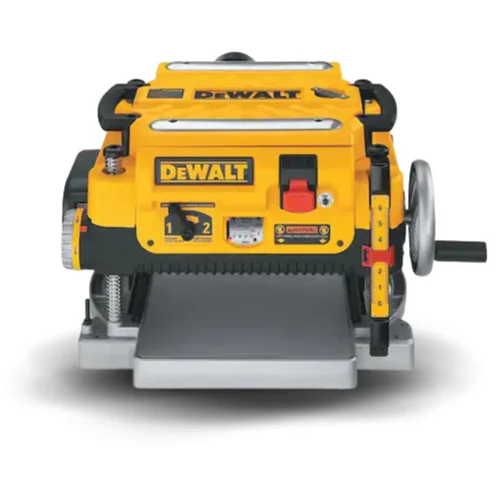
DeWalt (DW735X) Thickness PLaner
The DEWALT (DW735X) Thickness Planer is perfect for creating smooth, professional finishes on any wood. With a powerful motor, easy adjustments, and a stable base, it handles tough jobs effortlessly. Upgrade your woodworking projects with this reliable and efficient tool!
Key Features
My top-picked thickness planer is the DEWALT (DW735X) thickness planer. The powerful thickness planer, with an impressive 13-inch width capacity, two-speed gearbox, and three-knife cutter head, can help the beginner and the professional woodworker in different projects. Moreover, it can adjust the feed speed between 96 and 179 (CPI), providing a precise and smooth finish that makes it suitable for woodworking projects.
The second-best thickness planer [WEN (PL1326)] is also a viable option for woodworkers who love to work with spiral cutter heads instead of straight knife cutter heads. It also possesses a low noise level as compared to other units. With the powerful motor and feed speed of 26 FPM, you can get your boards a clean and smooth finish.
However, for efficiency in woodworking projects, you can consider the top third-thickness planer, the DEWALT (DW734) planer. It features double-edged and reversible blades that allow the ease of replacing the blades. Hence, it offers manageable maintenance of the thickness planer.
No matter what planer you choose, make sure to understand your projects and their needs so you buy the best and most suitable thickness planer.
FAQs
Is a thickness planer worth it?
Yes, thickness planer can be worth it for a lot of woodworkers. Initially, it seems costly, but it can be a one-time investment. It can save money by controlling the cost of buying the surfaced four side boards. Instead of smooth wood boards, you can buy rough lumbers that are far less expensive than S4s.
Can you use a thickness planer as a jointer?
Yes, you can use the benchtop planer as the jointer. If you don’t have a jointer at your home or workshop and need to cut a large piece of wood, then a planer can work for you. It can help you to flatten the wood pieces quickly.
How does a thickness planer work?
The thickness planer works on the mechanism of quick return motion. Following this mechanism, it moves forward and backward and performs its designated task. Mainly, it consists of two parts for performing the function; one is the fixed part, and the other one is the moveable part. While moving forward, it performs the cutting of wood and does not operate any operation while moving backward.
How to properly clean a thickness planer?
It is necessary to clean and dust off the thickness planer to enhance its shelf life and working efficiency. The cleaning of the thickness planer involved multiple steps.
- Start with cutting off the electricity by unplugging the thickness planer from the circuit.
- Then, clear the exterior of the planer by using the air compressor to dust off the chips and dust debris.
- Once you are done with the outer side of the planer, it’s time to clean the inner feed of the planer. Take the cleanser, spray it on the infeed and outfeed tray, and wipe it off.
- For operating the thickness planer, it worked on built-in rollers. The maintenance of these rollers is essential. You can use the same cleanser to clean these rollers and wipe them off with tissue.
- The next step is lubricating the posts, but first, clean them with the help of a cleanser. Before applying the glide coat, make sure the posts are entirely dry. Then, spray the glide coat by keeping it away from the rubber and plastic components.
Finish the cleansing by applying the paste wax on all the surfaces. Then leave it for volatilize. After some time, buff it off and get a nice shiny surface.